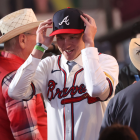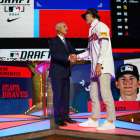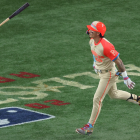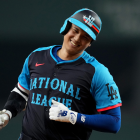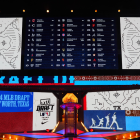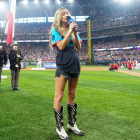
Last year, the NCAA awarded no Division I national championship in baseball for the first time since the title was forged back in 1947. That's of course because of the still ongoing COVID-19 pandemic, which caused college baseball to shut down in March and cancel all spring and winter championships. That, among other things, meant no 2020 College World Series.
Given that the pandemic is ongoing, nothing is to be assumed with regard to the 2021 college baseball season. However, as things stand now -- and as more and more people get vaccinated -- the intention is to crown a champion at the College World Series in Omaha, Nebraska which gets underway on June 19. Here's hoping.
Powered by such optimistic assumptions regarding college baseball in 2021, we're here to preview the season that begins very soon. We'll commence doing just that following the conclusion of this unnecessary sentence.
Composite 2021 preseason rankings
To get started, let's take a look at some composite rankings. What we've done is taken each of the six major preseason polls (Baseball America, Perfect Game, USA Today coaches' poll, D1Baseball.com, Collegiate Baseball, and the National Collegiate Baseball Writers' Association) and assigned "poll points" to each team ranked in the top 25 of each poll. No. 1-ranked teams get 25 points, No. 2-ranked teams get 24 points, all the way down to the No. 25-ranked teams, which get one point. So we add all the points up -- across, again, all six major polls -- and arrive at our composite preseason rankings.
Here's a look at what comes out of the wash for 2021:
| RANK | TEAM | POLL POINTS | CONFERENCE | 2020 RECORD |
|---|---|---|---|---|
1. | Florida | 150 | SEC | 16-1 |
2. | UCLA | 141 | Pac-12 | 13-2 |
3. | Texas Tech | 135 | Big 12 | 16-3 |
4. | Vanderbilt | 132 | SEC | 13-5 |
5. | Ole Miss | 126 | SEC | 16-1 |
6. | Louisville | 119 | ACC | 13-4 |
7. | Mississippi State | 106 | SEC | 12-4 |
8. | LSU | 97 | SEC | 12-5 |
9. | Miami | 86 | ACC | 12-4 |
10. | Virginia | 83 | ACC | 14-4 |
11. | UC-Santa Barbara | 79 | Big West | 13-2 |
12. | Arkansas | 76 | SEC | 11-5 |
T-13. | NC State | 74 | ACC | 14-3 |
T-13. | Texas | 74 | Big 12 | 14-3 |
15. | TCU | 66 | Big 12 | 11-4 |
16. | Arizona | 62 | Pac-12 | 10-5 |
T-17. | Florida State | 39 | ACC | 12-5 |
T-17. | Georgia Tech | 39 | ACC | 11-5 |
19. | East Carolina | 34 | American Athletic | 13-4 |
T-20. | South Carolina | 30 | SEC | 12-4 |
T-20. | Tennessee | 30 | SEC | 15-2 |
22. | Oklahoma State | 23 | Big 12 | 13-5 |
T-23. | Arizona State | 22 | Pac-12 | 13-4 |
T-23. | Michigan | 22 | Big Ten | 8-7 |
25. | West Virginia | 21 | Big 12 | 11-5 |
Also receiving poll points: Georgia (20), Auburn (13), Indiana (12), Duke (10), Wake Forest (10), Oklahoma (7), Central Florida (3), Coastal Carolina (3), Ohio State (3), Dallas Baptist (2), Alabama (1), Clemson (1)
So Florida topped all six polls, which accounts for their maxed-out total of 150 poll points. That's not surprising given that the Gators return almost every core contributor from last year's squad and complement that core with a top-tier recruiting class. Vanderbilt, who won the last national championship in 2019, checks in at fourth. The most recent College World Series runner-up, Michigan, is tied for 23rd and the only Big Ten team in the top 25 composite rankings. The last "Cinderella" to win it all -- depending upon how you define the somewhat imprecise term -- was Coastal Carolina in 2016, and if the preseason polls are any guide then UC-Santa Barbara would seem to have the best shot of becoming the next.
Conference rankings
Let's widen our scope a bit and cobble together some preseason conference rankings by adding up all the poll points conference by conference (we'll also include the "others receiving poll points" teams in our tabulations). The digits:
| CONFERENCE | PRESEASON POLL POINTS |
|---|---|
SEC | 781 |
ACC | 461 |
Big 12 | 330 |
Pac-12 | 203 |
Big West | 79 |
Tie - American Athletic, Big Ten | 37 |
Sun Belt | 3 |
Missouri Valley | 2 |
Not surprisingly, the SEC lords over all it surveys. Down yonder the conference boasts five of the top 10 teams in the composite rankings, and overall 11 of the conference's 14 teams received poll points (!). That's fully in keeping with recent history, as the SEC has claimed six of the last 11 national championships. The conference tied a record by placing four teams in the 2019 College World Series, and multiple SEC teams have made the eight-team College World Series in each of the last three seasons (2020 excepted, obviously).
As is typically the case, you see a significant drop-off in conference depth after the big four (SEC, ACC, Big 12, and Pac-10). In terms of building programs, baseball is a tough sport for cold-weather conferences, which explains why the Big Ten, unlike in football and basketball, isn't among the giants and hasn't been for a very long time. The conference has enjoyed a bit of a resurgence in recent years, which is largely explained by increased investment in the sport.
At the conference level, though, the headline remains the ongoing dominance of the SEC.
Key dates
How's about a brief walking tour of the college baseball calendar for 2021? How's about indeed.
- February 19-21: Opening weekend for Division I is highlighted by the 2021 State Farm College Baseball Showdown at Globe Life Field, home of the Texas Rangers. The showdown will feature No. 3 Texas Tech, No. 5 Ole Miss, No. 7 Mississippi State, No. 12 Arkansas, No. 13 Texas, and No. 15 TCU.
- May 25-30: The SEC Tournament goes down in Hoover, Ala. The ACC Tournament also covers these dates.
- May 26-30: The Big 12 Tournament takes place in Oklahoma City.
- May 31: It's Memorial Day and also Selection Monday, as the NCAA Tournament field of 64 is announced.
- June 19: The College World Series in Omaha begins.
- July 11-13: The 2021 MLB Draft takes place.
How the NCAA Tournament and College World Series work
Given that college baseball isn't as widely followed as the football and basketball collegiate variants, perhaps a brief postseason explainer is in order. Here's how it all works, in bullet-point format for today's harried sales professional ...
- The first round of play is known as the regional, and it's a round-robin, double-elimination format featuring four teams. Each of the 16 one-seeds hosts its respective regional, when possible. Only one team out of four survives each regional.
- The winner of each regional advances to the super regional, which a best-of-three series between two regional winnes.
- The winner of each super regional -- eight teams in all -- advances to the College World Series in Omaha.
- The College World Series is a double-elimination format until the final two teams are left standing. At that point, the slates are wiped clean, and it's a best-of-three series to determine the national champion.
- The field of 64 also includes eight national national seeds, which you may consider the pre-tourney favorites to reach Omaha. National seeds get to host super regionals should they advance that far.
So, yes, it's quite different from the more familiar March Madness format, but it typically entails similar levels of, you know, madness.
Players to watch
Top draft-eligible D1 collegians -- i.e., juniors, seniors, or sophomores who will turn 21 before the draft -- include Vanderbilt right-handers Kumar Rocker and Jack Leiter, UCLA shortstop Matt McLain, Miami-FL catcher Adrian Del Castillo, Florida outfielder Jud Fabian, LSU right-hander Jaden Hill, Louisville third baseman Alex Binelas, Texas right-hander Ty Madden, Sam Houston outfielder Colton Cowser, Wake Forest shortstop Kahlil Watson, and Kansas State lefty Jordan Wicks. That's of course a partial listing, as the season to come could drastically change draft stock up and down the board.
Our own R.J. Anderson has a more in-depth look at the 2021 draft class. In the meantime, please enjoy some footage of Rocker, who's in the mix for top overall pick, cutting a swath through the 2019 NCAA Tournament:
A bit of history
In conclusion, let's run down all the past college baseball national champions and runners-up:
| YEAR | NATIONAL CHAMPION | RUNNER-UP |
|---|---|---|
| 2020 | None | None |
| 2019 | Vanderbilt (59-12) | Michigan |
| 2018 | Oregon State (55-12-1) | Arkansas |
| 2017 | Florida (52-19) | LSU |
| 2016 | Coastal Carolina (55-18) | Arizona |
| 2015 | Virginia (44-24) | Vanderbilt |
| 2014 | Vanderbilt (51-21) | Virginia |
| 2013 | UCLA (49-17) | Mississippi State |
| 2012 | Arizona (48-17) | South Carolina |
| 2011 | South Carolina (55-14) | Florida |
| 2010 | South Carolina (54-16) | UCLA |
| 2009 | LSU (56-17) | Texas |
| 2008 | Fresno State (47-31) | Georgia |
| 2007 | Oregon State (49-18) | North Carolina |
| 2006 | Oregon State (50-16) | North Carolina |
| 2005 | Texas (56-16) | Florida |
| 2004 | Cal State Fullerton (47-22) | Texas |
| 2003 | Rice (58-12) | Stanford |
| 2002 | Texas (57-15) | South Carolina |
| 2001 | Miami (Fla.) (53-12) | Stanford |
| 2000 | LSU (52-17) | Stanford |
| 1999 | Miami (Fla.) (50-13) | Florida State |
| 1998 | Southern California (49-17) | Arizona State |
| 1997 | LSU (57-13) | Alabama |
| 1996 | LSU (52-15) | Miami (Fla.) |
| 1995 | Cal State Fullerton (57-9) | Southern California |
| 1994 | Oklahoma (50-17) | Georgia Tech |
| 1993 | LSU (53-17-1) | Wichita State |
| 1992 | Pepperdine | Cal State Fullerton |
| 1991 | LSU (55-18) | Wichita State |
| 1990 | Georgia (52-19) | Oklahoma State |
| 1989 | Wichita State (68-16) | Texas |
| 1988 | Stanford (46-23) | Arizona State |
| 1987 | Stanford (53-17) | Oklahoma State |
| 1986 | Arizona (49-19) | Florida State |
| 1985 | Miami (Fla.) (64-16) | Texas |
| 1984 | Cal State Fullerton (66-20) | Texas |
| 1983 | Texas (66-14) | Alabama |
| 1982 | Miami (Fla.) (55-17-1) | Wichita State |
| 1981 | Arizona State (55-13) | Oklahoma State |
| 1980 | Arizona (45-21-1) | Hawaii |
| 1979 | Cal State Fullerton (60-14-1) | Arkansas |
| 1978 | Southern California (54-9) | Arizona State |
| 1977 | Arizona State (57-12) | South Carolina |
| 1976 | Arizona (56-17) | Eastern Michigan |
| 1975 | Texas (59-6) | South Carolina |
| 1974 | Southern California (50-20) | Miami (Fla.) |
| 1973 | Southern California (51-11) | Arizona State |
| 1972 | Southern California (47-13-1) | Arizona State |
| 1971 | Southern California (46-11) | Southern Illinois |
| 1970 | Southern California (45-13) | Florida State |
| 1969 | Arizona State (56-11) | Tulsa |
| 1968 | Southern California (43-12-1) | Southern Illinois |
| 1967 | Arizona State (53-12) | Houston |
| 1966 | Ohio State (27-6-1) | Oklahoma State |
| 1965 | Arizona State (54-8) | Ohio State |
| 1964 | Minnesota (31-12) | Missouri |
| 1963 | Southern California (35-10) | Arizona |
| 1962 | Michigan (34-15) | Santa Clara |
| 1961 | Southern California (36-7) | Oklahoma State |
| 1960 | Minnesota (34-7-1) | Southern California |
| 1959 | Oklahoma State (27-5) | Arizona |
| 1958 | Southern California (29-3) | Missouri |
| 1957 | California (35-10) | Penn State |
| 1956 | Minnesota (37-9) | Arizona |
| 1955 | Wake Forest (29-7) | Western Michigan |
| 1954 | Missouri (22-4) | Rollins |
| 1953 | Michigan (21-9) | Texas |
| 1952 | Holy Cross (21-3) | Missouri |
| 1951 | Oklahoma (19-9) | Tennessee |
| 1950 | Texas (27-6) | Washington State |
| 1949 | Texas (23-7) | Wake Forest |
| 1948 | Southern California (26-4) | Yale |
| 1947 | California (31-10) | Yale |
Soon enough, we'll be adding another champ to this list (one hopes, anyway). In the meantime, enjoy the presumed baseball!











